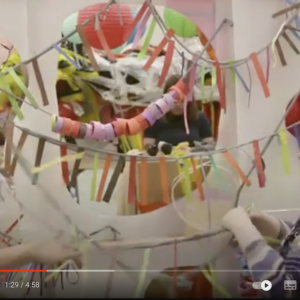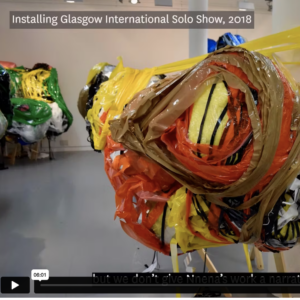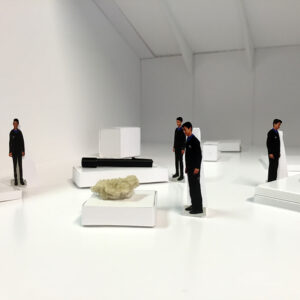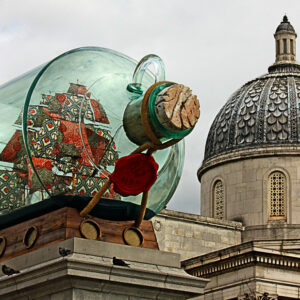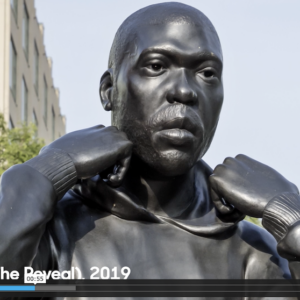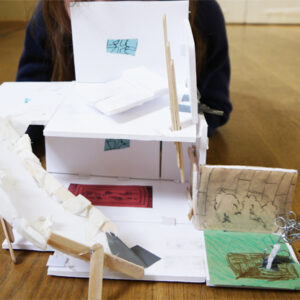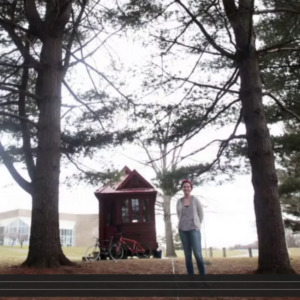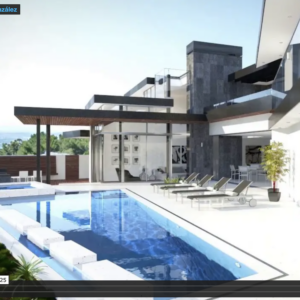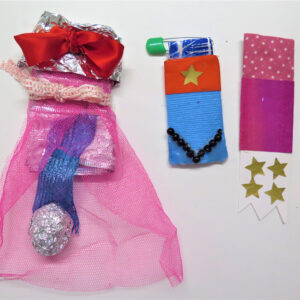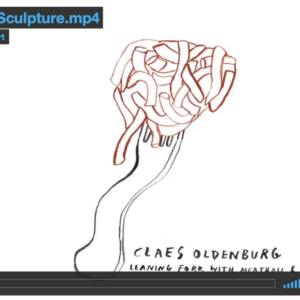Scrapstores are a fantastic resource for running any group that supports visual arts learning!
If you run an after-school art club, visiting your local scrap store can help you access a wide range of high-quality art and craft materials for your members. The range of materials in scrapstores changes from day to day and could include card, paper, textiles, paint, corks, wool, cardboard tubes, netting, gauze and a thousand other things!
All scrapstores have different means of accessing their scrap materials. In some, you need to pay an individual membership fee, whilst in others, you simply pay for the scrap you take on the day. Below is a list of scrapstores nationwide, with contact details for each. If you are interested in listing your scrap store on the AccessArt website, then please contact rachel@accessart.org.uk.
You can see inspiring resources on using scrapstore materials here: A Wealth of Materials
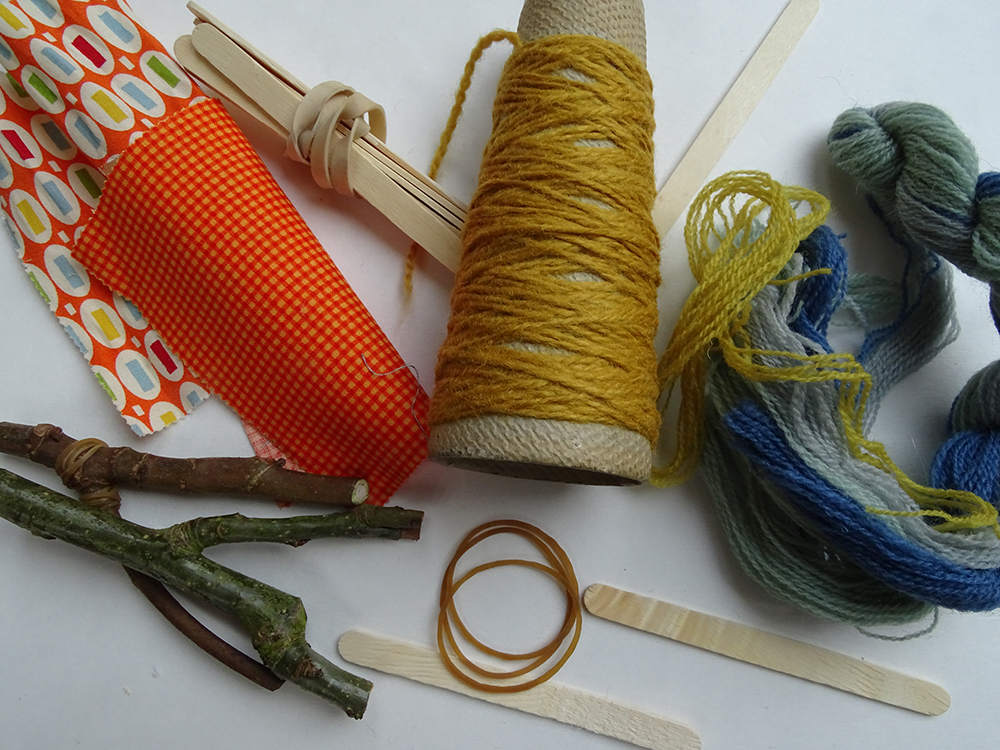
Use this directory to find a scrapstore near you.
Renée Materials (Online)
“Renée Materials reduces waste and cuts emissions on a large scale by offering businesses’ off-cuts, surplus stock, and leftover materials for reuse. We feature high-quality materials like paper, wood, textiles, leather, glass, metal, and yarn through our marketplace.”
Birmingham Playcentre Network, Birmingham
“Enjoy the joy of crafting while helping the environment at BPCN.”
Address and Opening Times:
Birmingham Playcare Network
Hollymoor Centre
8 Manor Park Grove
Birmingham
B31 5ER
Tuesday – Friday 10.00 am- 4.00 pm
1st and 3rd Saturday of the month 10.00 am – 2.00 pm
Children’s Scrapstore, Bristol
“The Children’s Scrapstore is a reuse charity dedicated to helping businesses divert reusable waste away from landfill/energy recovery to help improve art and play opportunities for children, young people and adults.”
Address and Opening Times:
Scrapstore House
21 Sevier Street
Bristol
BS2 9LB
Tuesday, Wednesday, Friday, Saturday 10.00 am – 5.00 pm
Thursday 11.00 am – 5.00pm
Re-Imagine Resource Centre, Cambridgeshire
“At Re-Imagine, we are finding creative ways to help look after our planet. We are passionate about being creative to be well, and I provide making sessions in-store and run outreach workshops for all types of groups, as well as a fully stocked resource warehouse full of amazing items to be turned into something eco-fabulous.
We collect wonderful materials that businesses normally just throw away, and for a tiny fee, make them available for you to transform into works of art, to play with or wherever your imagination leads…”
Address and Opening Times:
We are on the same site as Witchford Household Recycling Centre.
Witchford Household Recycling Centre
Stirling Way
Witchford
CB6 3FA
Wednesday 10.00am – 2.00pm
Saturday 10.00am – 12.00pm
Bits and Bobs, Cambridge
“Our Scrapstore is named Bits and Bobs because that’s exactly what you’ll find. In amongst the rolls of colourful card, massive containers full of fabric scraps, there are lots of things we don’t even have names for.”
Address and Opening Times:
3 Commercial Road
March
Cambridgeshire
PE15 8QP.
Factory Shop open to members:
Wednesdays and Thursdays, 9.30am to 4pm
Fridays and Saturdays, 9.30am to 2pm
Play and Recycling Centre, Derby
“PARC is a registered charity in Derby providing mountains of fantastic, recycled resources as well as opportunities for people to learn about how we can actively support our environment through reducing waste, re-using and recycling.
We offer recycled resources and materials and prevent these going into landfill. We process these to provide low-cost resources. We encourage creativity and provide opportunities to gain creative skills and share our ideas for how resources can be used. We want people to re-cycle, recycle, repurpose and re-love materials and reduce landfill.
Low priced recycled materials such as wools, fabrics, beads, ribbon, haberdashery, vinyl sheets, blind fabrics, art paper and paints, craft resources and household paint.”
Address and Opening Times:
Play And Recycling Centre
6 – 10 Werburgh Street
Derby
DE22 3QG
01332 299165
Monday, Tuesday, Wednesday 10am-2pm
First and Third Saturday of every month 9:15am-2pm
Artytime Scrapstore, East Sussex
“Using Artytime Scrapstore is a brilliant way to reuse materials and promote recycling. These materials may be supplied to individuals, families and schools. As well as playgroups, holiday clubs, special needs groups and other community organisations such as Scouts and Guides. Please ask about our large group membership. Most of the materials will be free, however some may have a small charge.”
Address and Opening Times:
Jarvis Brook recreational park
Crowborough
East Sussex
TN6 2EG
Monday 3.30 pm – 5.30 pm
Tuesday 9.30am – 11.30 am
Wednesday 9.30 am – 11.30 am
Thursdays 4.00 pm – 6.00 pm
Every second Sunday and the last Sunday of the month, 10.00 am – 12.00 pm.
The Gloucestershire Resource Centre, Gloucester
“The Gloucestershire Resource Centre has been promoting creativity in the arts, health, play and education sector through the re-use of materials from industry and business for over 32 years now. We don’t specialise in any type of materials as we have to run with the surplus being generated by local businesses within our catchment of Gloucestershire at the time, We rely on the national community of scrap stores to exchange materials, we we can provide variety and choice for our 1300 plus members.”
Address and Opening Times:
City Works
Alfred Street
Gloucester
GL14DF
Tuesday 10:00 am – 7:00pm
Wednesday 10:00am – 5:00pm
Thursday 10:00am – 5:00pm
Plus occasional Saturdays 10am – 1pm
The Children’s SCRAP Project, Hackney
“The Children’s S.C.R.A.P project is a registered charity No. 281010 which collects, stores and distributes clean, safe, industrial waste to schools, nurseries, colleges, special needs groups, churches, hospital wards, playgroups, community groups and charitable organisations involved in education.”
Address and Opening Times
137 Homerton High St
London
E9 6AS
Monday 10.00 am – 6.45 pm
Tuesday-Thursday 12.00 pm – 4.45 pm
Rose Tinted Rags, Hereford
Rose Tinted Rags is a “textile Resource & Arts Centre selling Vintage and Modern fabrics, haberdashery, curtains, antique lace, wool and assorted miscellanea. Arts workshop working with adults with disabilities.”
Address and Opening Times:
Monday 9:30am – 4:30pm
Tuesday 9:30am – 4:30pm
Wednesday 9:30am – 4:30pm
Union Walk
Commercial Rd
The Country Bus Station
Hereford
Ragtag Arts, Kendal
“The environment is at the heart of our Ragtag Arts. This is evident in all that we do, from running the community scrapstore, making repurposed craft kits, working in partnership with sustainable providers, and our extensive workshop program in schools and at events and festivals.”
Address and Opening Times:
Unit 16 Mealbank Mill Ind Est
Mealbank
Kendal
LA8 9DL
Tuesday: 10am – 4pm
Thursday: 10am – 6pm
Friday: 10am – 4pm
Saturday: 10am – 4pm
Work and Play Scrap Store, London
“Do you need inspiring, cheap arts and crafts and design materials, or props for your productions or unusual creative play resources?
Do you want to use more sustainable materials?
For an economical fee, you, your school or your group can join the Work and Play Scrapstore based in Tooting and have unlimited access to our materials for your projects, all of which are saved from landfill.
Paper and paint, textiles and trimmings, buttons and bubble wrap, wood, foam, fine wire, and so much more… come and visit us and see for yourself.
No need to book an appointment, just come and look around!”
Address and Opening Times:
Hazelhurst Estate
13 Blackshaw Road
Tooting
SW17 0DA
Tuesday 11.00am-5.00pm
Thursday 11:00-5pm
Every first Saturday of the month, 11.00am-4.00pm
Every third Sunday of the month, 11.00am-4.00pm
Community Scrapstore, North Somerset
“The Community Scrapstore is an Aladdin’s cave full of marvellous and sometimes quirky resources that will fire the imagination and spark creativity and play.”
Address and Opening Times:
66 Gazelle Road
Weston-super-Mare
BS24 9ES
Monday: 11.00 am – 4.00 pm
Tuesday: 9.00 am – 1.00 pm
Thursday and Friday: 11.00 am – 4.00 pm
Saturday: 9.00 am – 2.00 pm
Orinoco Scrapstore, Oxford
“Orinoco is an Oxfordshire scrap store with a long history of using creativity, craft and play to inspire the reuse of materials that would otherwise end up in landfills. It would be easy to assume that this little charity is all about scrap, but take a look behind the lorry loads of materials saved, and you’ll find a source of affordable resources for schools and organisations working with children and young people across Oxfordshire. For more information, have a look at our website.”
Address and Opening Times:
111-113 Pound Way
Templars Square Shopping Centre
Cowley
OX4 3XH
Tel. 07763 923746
Email. oxford@orinoco.org.uk
Tuesday 12-4pm
Wednesday – Saturday 10.30am to 4.30pm
Community Scrap Shack, Stone-on-Trent
Community Scrapstore “is an ‘Aladdin’s Cave’ full of exciting and affordable reclaimed resources suitable for use in play and creativity, and is open to families, individuals, schools and community groups as day or annual members.”
Address and Opening Times:
Unit 2
7 China Street
Fenton
Stoke-on-Trent
ST4 3NJ
Tuesday and Wednesday 10.00 am – 5.00 pm
Saturday 10.00 am – 1.00 pm
The Recycle Yard, Wakefield
“The Recycle Yard Ltd recycles waste from the local area that can be reused for arts, crafts and play. We support local schools, nurseries, community groups, charity groups etc by supplying them with low cost materials or through donations.”
Address and Opening Times:
16D Healey Road
Ossett
United Kingdom
Monday 10:00 am – 2:00pm
Tuesday 10:00 am – 2:00pm
Wednesday 10:00 am – 4:00opm
Saturday 10:00 am – 2:00pm
Use this directory to find a scrapstore near you.
